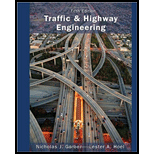
Concept explainers
(a)
The volume of traffic across the bridge.
Answer to Problem 3P
The volume of traffic across the bridge is
Explanation of Solution
Given:
The total cost to travel across bridge except tolls is expressed as,
Here,
The demand to travel across the bridge is,
Calculations:
Calculate volume of traffic across the bridge.
The total cost to travel across bridge except tolls is,
The volume across the bridge is,
Solve Equations (I) and (II).
Conclusion:
Therefore, the volume of traffic across the bridge is
(b)
The volume of traffic across the bridge if a toll of
Answer to Problem 3P
The volume of traffic across the bridge if a toll of
Explanation of Solution
Concept used:
Write the expression to calculate the volume expected for a
Here,
Calculations:
Calculate volume of traffic across the bridge if toll is increased to
The new cost of the cost of travel across bridge is,
Substitute
Calculate volume of traffic expected for a
Substitute
Conclusion:
Therefore, the volume of traffic across the bridge if a toll of
(c)
The volume of traffic across the bridge.
Answer to Problem 3P
The volume of traffic across the bridge is
Explanation of Solution
Given:
The total cost to travel across bridge including toll is expressed as,
Calculations:
Calculate volume of traffic across the bridge.
Substitute
Conclusion:
Therefore, the volume of traffic across the bridge is
(d)
The toll to yield the highest revenue for demand and supply function and the associated demand and revenue.
Answer to Problem 3P
The toll which yield the highest revenue for demand and supply function is
Explanation of Solution
Concept used:
Write the expression to calculate the revenue generated.
Here,
Calculations:
Assume the toll rate as
The new cost of the cost of travel across bridge is,
Substitute
Substitute
From the above equation, the toll which would yield the maximum revenue is 100 cents or
Substitute
Calculate the demand for travel across the bridge for maximum revenue.
Substitute
Conclusion:
Therefore, the toll which yield the highest revenue for demand and supply function is
Want to see more full solutions like this?
Chapter 2 Solutions
Traffic and Highway Engineering - With Mindtap
- Draw the shear and the moment diagrams for each of the frames below. If the frame is statically indeterminate the reactions have been provided. Problem 1 (Assume pin connections at A, B and C). 30 kN 2 m 5 m 30 kN/m B 60 kN 2 m 2 m A 22 CO Carrow_forwardThis is an old exam practice question. The answer key says the answer is Pmax = 52.8kN but I am confused how they got that.arrow_forwardF12-45. Car A is traveling with a constant speed of 80 km/h due north, while car B is traveling with a constant speed of 100 km/h due east. Determine the velocity of car B relative to car A. pload Choose a File Question 5 VA - WB VBA V100 111413 + *12-164. The car travels along the circular curve of radius r = 100 ft with a constant speed of v = 30 ft/s. Determine the angular rate of rotation è of the radial liner and the magnitude of the car's acceleration. Probs. 12-163/164 pload Choose a File r = 400 ft 20 ptsarrow_forward
- P6.16 A compound shaft (Figure P6.16) consists of a titanium alloy [G= 6,200 ksi] tube (1) and a solid stainless steel [G= 11,500 ksi] shaft (2). Tube (1) has a length L₁ = 40 in., an outside diameter D₁ = 1.75 in., and a wall thickness t₁ = 0.125 in. Shaft (2) has a length 42 = 50 in. and a diameter d₂ = 1.25 in. If an external torque TB = 580 lb ft acts at pulley B in the direction shown, calculate the torque Tcrequired at pulley C so that the rotation angle of pulley Crelative to A is zero. B Te (2) TB (1) FIGURE P6.16arrow_forward7.43 Neglecting head losses, determine what horsepower the pump must deliver to produce the flow as shown. Here, the elevations at points A, B, C, and D are 124 ft, 161 ft, 110 ft, and 90 ft, respectively. The nozzle area is 0.10 ft². B Nozzle Water C Problem 7.43arrow_forwardA 1.8m x 1.8m footing is located at a depth of 1 m below the ground surface in a deep deposit of compacted sand (f'= 33 , f' = 28 , γ = 17.5 kN/m). Calculate the ultimate net bearing capacity considering several factors (e.g., shape, depth, and inclination) when the groundwater table is located (a) at 5 m below the footing base, (b) at the ground surface, (c) at the footing base, and (d) at 1.5 m below the footing base. Also, explain the effects of the groundwater levels in the bearing capacities of the footing with your own words. If the information is not given for the calculation, please assume it reasonably.arrow_forward
 Traffic and Highway EngineeringCivil EngineeringISBN:9781305156241Author:Garber, Nicholas J.Publisher:Cengage Learning
Traffic and Highway EngineeringCivil EngineeringISBN:9781305156241Author:Garber, Nicholas J.Publisher:Cengage Learning Fundamentals Of Construction EstimatingCivil EngineeringISBN:9781337399395Author:Pratt, David J.Publisher:Cengage,
Fundamentals Of Construction EstimatingCivil EngineeringISBN:9781337399395Author:Pratt, David J.Publisher:Cengage, Solid Waste EngineeringCivil EngineeringISBN:9781305635203Author:Worrell, William A.Publisher:Cengage Learning,
Solid Waste EngineeringCivil EngineeringISBN:9781305635203Author:Worrell, William A.Publisher:Cengage Learning, Engineering Fundamentals: An Introduction to Engi...Civil EngineeringISBN:9781305084766Author:Saeed MoaveniPublisher:Cengage Learning
Engineering Fundamentals: An Introduction to Engi...Civil EngineeringISBN:9781305084766Author:Saeed MoaveniPublisher:Cengage Learning



